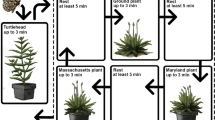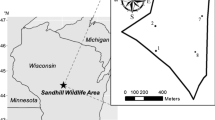Summary
Two species ofEuphydryas butterflies were studied in California, USA, and showed considerable diet overlap at the species level. They utilize many of the same plant genera for oviposition. However,E. editha is less likely to use woody perennials than isE. chalcedona.
Both butterfly species are known to specialize on different host plants in different populations, so species level divergence may not be a good predictor of community level divergence. Within five communities,E. editha andE. chalcedona showed no dietary overlap. A major component of the niche ofE. editha in one community was occupied byE. chalcedona in a second community, even though both butterfly species occupied both communities. These resource use patterns indicate that community level interactions may affect diet divergence. The degree to which divergence within communities is greater (or less) than expected from a species level comparison may be used to provide a measure of community organization. Equations are given in the Appendix for calculating overlap probabilities from presence/absence types of data; in this study, presence is oviposition on a particular plant species, absence is no oviposition on that plant species. Given the various assumptions of the model,E. editha andE. chalcedona show significant community level components of their dietary divergence in the areas studied. However, in some other communitiesE. editha andE. chalcedona do share host plant species. Therefore, we could not demonstrate community level divergence conclusively, nor has this been demonstrated for any other pair of insect herbivore species. We do not know whether this is because the phenomenon is truly rare or just very hard to demonstrate.
Similar content being viewed by others
References
Brown, I. L. and Ehrlich, P. R. (1980) Population biology of the checkerspot butterflyEuphydryas chalcedona. Structure of the Jasper Ridge colony.Oecologia 47, 239–51.
Brues, C. T. (1924) The specificity of food-plants in the evolution of phytophagous insects.Amer. Natur. 58, 127–44.
Case, T. J. and Sidell, R. (1983) Pattern and chance in the structure of model and natural communities.Evolution 37, 832–49.
Chew, F. S. (1981) Coexistence and local extinction in two pierid butterflies.Amer. Natur. 118, 655–72.
Colwell, R. K. and Winkler, D. W. (1984) A null model for null models in biogeography. InEcological Communities: Conceptual Issues and the Evidence (D. R. Strong, D. Simberloff, L. Abele and A. B. Thistle, eds). pp. 344–59. Princeton Univ. Press, N.J.
Ehrlich, P. R. and Raven, P. (1965) Butterflies and plants: a study in coevolution.Evolution 18, 586–608.
Fritz, R. S., Sacchi, C. F. and Price, P. W. (1986) Competition versus host plant phenotype in species composition: willow sawflies.Ecology 67, 1608–18.
Gilbert, L. E. (1979) Development of theory in the analysis of insect-plant interactions. InAnalysis of Ecological Systems (D. J. Horn, G. R. Stairs and R. D. Mitchell, eds) pp. 117–54. Ohio State Univ. Press, Columbus.
Harvey, P. H., Colwell, R. K., Silvertown, J. W. and May, R. M. (1983) Null models in ecology.Ann. Rev. Ecol. Syst. 14, 189–211.
Holdren, C. E. and Ehrlich, P. R. (1982) Ecological determinants of food plant choice in the checkerspot butterflyEuphydryas editha in Colorado.Oecologia 52, 417–23.
Murphy, D. D. (1983) Nectar sources as constraints on the distribution of egg masses by the checkerspot butterflyEuphydryas chalcedona.Environ. Ent. 12, 463–66.
Murphy, D. D. and Ehrlich, P. R. (1983) Biosystematics of theEuphydryas of the Central Great Basin with the description of a new subspecies.J. Res. Lepid. 22, 254–61.
Rausher, M. D., Mackay, D. A. and Singer, M. C. (1981) Pre- and post-alighting host discrimination byEuphydryas editha butterflies: the behavioural mechanisms causing clumped distributions of egg clusters.Anim. Behav. 29, 1220–8.
Schoener, T. W. (1988) Testing for non-randomness in sizes and habitats of West Indian lizards: choice of species pool affects conclusions from null models.Evol. Ecol. 2, 1–26.
Singer, M. C. (1971) Evolution of food-plant preference in the butterflyEuphydryas editha.Evolution 25, 383–9.
Singer, M. C. (1972) Complex components of habitat suitability within a butterfly colony.Science 176, 75–7.
Singer, M. C. (1983) Determinants of multiple host use by a phytophagous insect population.Evolution 37, 389–403.
Smiley, J. (1978) Plant chemistry and the evolution of host specificity: new evidence fromHeliconius andPassiflora.Science 201, 745–7.
Strong, D. R., Szyska, L. A. and Simberloff, D. (1979) Tests of community-wide character displacement against null hypotheses.Evolution 33, 897–913.
Strong, D. R., Lawton, J. H. and Southwood, T. R. E. (1984)Insects on plants: community patterns and mechanisms. Blackwell, Oxford.
Thomas, C. D., Ng, D., Singer, M. C., Mallet, J. L. B., Parmesan, C. and Billington, H. L. (1987) Incorporation of a European weed into the diet of a North American herbivore.Evolution 41, 892–901.
White, R. R. and Singer, M. C. (1974) Geographical distribution of hostplant choice inEuphydryas editha.J. Lepid. Soc. 28, 103–7.
Zwölfer, H. (1977) Der Informationswert faunistischer Daten fur populationokologische Untersuchungen: Das Verteilungsmuster der Wirtstrassen vonLarinus sturnus Schall undL. jaceae F. (Coleoptera: Curculionidae).Verh. des Sechen Int. Symp. uber Entomofaunistik in Mitteluropa.Junk, The Hague. pp. 209–19.
Zwölfer, H. (1979) Strategies and counterstrategies in insect population systems competing for space and food in flower heads and plant galls.Fortschr. Zool. 25, 331–53.
Author information
Authors and Affiliations
Rights and permissions
About this article
Cite this article
Thomas, C.D., Vasco, D., Singer, M.C. et al. Diet divergence in two sympatric congeneric butterflies: Community or species level phenomenon?. Evol Ecol 4, 62–74 (1990). https://doi.org/10.1007/BF02270716
Issue Date:
DOI: https://doi.org/10.1007/BF02270716




